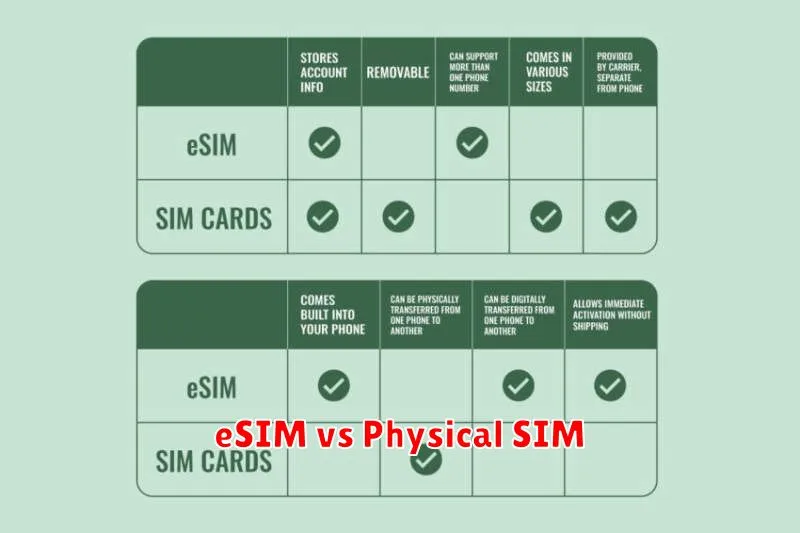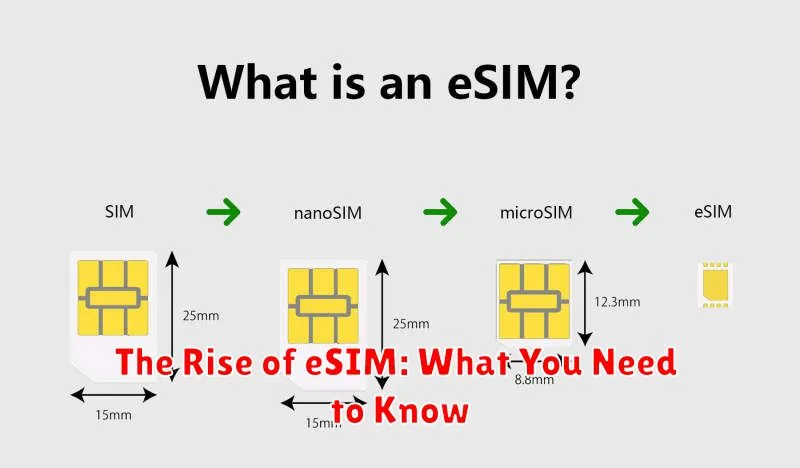The digital age is rapidly transforming how we connect, and the eSIM is at the forefront of this evolution. An embedded SIM, or eSIM, is revolutionizing the way we connect our devices to mobile networks. No longer are we tethered to physical SIM cards; the eSIM offers a new level of flexibility and convenience for managing our mobile connectivity. This article will delve into the rise of the eSIM, exploring what it is, how it works, and the benefits it offers to consumers and businesses alike. Understanding the eSIM is crucial for anyone looking to stay ahead of the curve in the ever-evolving world of mobile technology.
From smartphones and wearables to IoT devices, the eSIM is impacting a wide range of industries. Whether you are considering switching to an eSIM enabled device or simply curious about this emerging technology, this article will provide you with the essential information you need to know. We will explore the advantages of eSIM technology over traditional SIM cards, examine its potential impact on the telecommunications industry, and discuss the future of the eSIM and its role in the growing interconnected world. Discover the key features and functionality of the eSIM and gain valuable insights into the exciting possibilities it unlocks.
What Is an eSIM and How It Works
An eSIM, or embedded SIM, is a digital SIM card that’s built directly into your device. Unlike traditional physical SIM cards, you don’t need to physically swap them out. Instead, you can activate a cellular plan from a carrier digitally.
It works by downloading your carrier’s profile information onto the eSIM chip within your device. This profile contains the necessary data to connect you to their network. This allows you to switch carriers or plans more easily than with physical SIMs.
eSIM vs Physical SIM

The core difference between an eSIM and a physical SIM lies in their form factor. A physical SIM is a small, removable card that stores your subscriber information, while an eSIM is embedded directly into your device. This means no more fumbling with tiny SIM trays or worrying about losing your SIM card.
With an eSIM, you can activate a cellular plan digitally, often directly through your device’s settings. Physical SIMs require you to physically obtain and insert the SIM card into your device. This makes switching carriers or activating international plans easier and faster with an eSIM.
Benefits for Travelers and Dual-SIM Users
eSIMs offer significant advantages for frequent travelers. Switching between local carriers in different countries becomes significantly easier. This eliminates the need to physically swap SIM cards, saving you the hassle and potential loss of a physical SIM.
For dual-SIM users, eSIMs provide the convenience of having two numbers on a single device. This is particularly beneficial for separating work and personal communications or maintaining a local number while traveling internationally. You can easily switch between profiles without physically managing two separate SIM cards.
Cost savings can also be a key benefit. By utilizing local eSIM profiles while abroad, travelers can often avoid expensive roaming charges from their home carriers. This allows for more affordable data and voice services while traveling.
How to Activate eSIM on Android and iPhone
Activating an eSIM is generally a straightforward process, though it varies slightly depending on your device and carrier. Ensure your device is compatible with eSIM technology and your carrier supports it.
Android eSIM Activation
On most Android phones, you’ll navigate to Settings > Network & internet > Mobile network > + Add mobile plan. Your carrier will provide a QR code to scan, or you may be able to download the eSIM profile directly from their app.
iPhone eSIM Activation
For iPhones, go to Settings > Cellular > Add Cellular Plan. Similar to Android, you will scan a QR code provided by your carrier, or you may be prompted to enter details manually if downloading the profile directly.
eSIM-Compatible Devices in 2025
By 2025, eSIM compatibility is expected to be even more widespread. Smartphones will continue to lead the charge, with the vast majority of new models offering eSIM support.
Tablets and wearables (smartwatches, fitness trackers) will also see increased eSIM adoption. This allows for standalone connectivity, independent of a smartphone.
Laptops and IoT devices (Internet of Things) will also increasingly integrate eSIM technology. This will simplify connectivity management for these devices, particularly beneficial for deployments in remote or challenging environments.
The automotive sector will see growth in connected car models leveraging eSIM technology for functionalities like in-car Wi-Fi hotspots, navigation, and emergency services.
Security and Portability Factors
eSIMs offer enhanced security compared to physical SIM cards. The inability to physically remove the eSIM reduces the risk of SIM swapping, a fraudulent practice where criminals gain access to a user’s phone number. Furthermore, the digital nature of eSIM profiles allows for remote provisioning and management, simplifying security updates and patching vulnerabilities.
Portability is a key advantage of eSIM technology. Users can switch carriers seamlessly without physically swapping SIM cards. This is particularly beneficial for international travelers who can activate local profiles upon arrival. The ability to store multiple profiles on a single device further enhances portability, allowing users to easily switch between different networks and plans.

